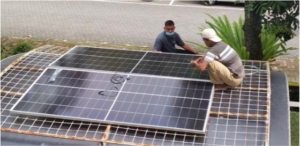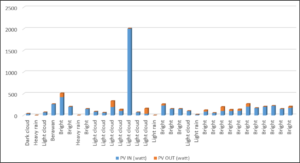REVIEW AND DEVELOPMENT POLICY RECOMMENDATIONS SUSTAINABLE CAMPUS AT THE ISLAMIC UNIVERSITY OF INDONESIA
“Installation of Solar Power Plant on the Gazebo Roof at the Faculty of Mathematics and Natural Sciences (FMNS) Islamic University of Indonesia”
Riyanto & M. Miqdam Musawwa
Department of Chemistry, Faculty of Mathematics and Natural Sciences, Indonesian Islamic University, Jl. Kaliurang KM 14,5 Sleman Yogyakarta, 55584
Email: [email protected]
1.1 Background
In general, energy sources are grouped into non-renewable and renewable energy. Non- renewable energy is energy whose consumption rate reduces its reserves and takes a long time to produce. Energy sources such as non-renewables such as coal, petroleum, and gas are known as fossil fuels. Based on their energy products, fossil fuels release the largest volume of greenhouse gases (GHG), including carbon dioxide (CO2) and sulfur dioxide (SO2), which cause environmental impacts, namely pollution and acid rain, which cause pollution of water flowing in rivers and consequently affecting the entire ecosystem. Increased CO2 levels are directly correlated with energy production and economic development in a country, so they can be reduced through proper policy monitoring and evaluation. Therefore, it is not desirable to control CO2 emissions by making shallow policies and avoiding issues such as the economy and energy production.
According to current statistics, the global population has reached 8 billion people and is expected to exceed 9 billion by 2050. In addition, the emergence of new technologies and changes in the way energy is used can shape the future of energy. Due to population growth and technological change, global energy consumption and the energy economy will also expand, as the world’s gross energy production will double from $85 billion in 2012 to $250–300 billion in 2050. Pollution and scarce resources and increasing demand for energy, have attracted much attention to replacing fossil fuels with renewable energy, exploiting sustainable socioeconomic and environmental resources, including solar, wind, and geothermal energy. Currently, less than 20% of global energy consumed comes from renewable energy and is projected to reach 50% by 2040. Currently, solar energy is the focus of renewable energy sources, so it is estimated that around 11% of energy demand will be met by solar energy in 2050.
A solar power plant is a power plant that converts solar energy into electrical energy. A photovoltaic type of solar power plant is a power plant that uses a voltage difference due to the photoelectric effect to generate electricity. Solar panels consist of three layers, the P panel layer at the top, the boundary layer in the middle, and the N panel layer at the bottom. The photoelectric effect is where sunlight causes electrons in the P panel layer to be released, so this causes protons to flow to the N panel layer at the bottom and this proton current transfer is an electric current.
The advantages of using a Solar Power Plant are reducing long-term electricity costs, reducing dependence on electricity from coal, avoiding the impact of power outages, and reducing global warming because the solar panel system produces environmentally
friendly energy that does not cause pollution. The components needed by Solar Power Plants are Solar Modules/PV Panels, Solar Charge Controllers, Batteries, DC to AC Inverters (used to turn on devices whose input voltage is 220 V such as TV, Radio, Refrigerator, and others).
The proposed policy is to make a gazebo at FMNS Islamic University of Indonesia using Solar Power Plant. Solar energy is green energy and does not pollute the environment. Solar energy is also efficient and more environmentally friendly. The advantages of using solar power plants are that they help save energy, have no harmful emissions, are a renewable energy source, solar panels last a long time and require little maintenance, do not contribute to water pollution, do not contribute to noise pollution, are the most versatile energy source, and help slow climate change.
The campus gazebo has various benefits for all campus activities, as well as a facility for channeling student creativity. Creative and productive students usually need a comfortable atmosphere and place to get ideas and inspiration. The campus gazebo is equipped with facilities and infrastructure such as Wi-Fi and electricity. So far, the gazebo on campus uses electricity from State Electricity Company (PLN). Therefore, in this proposal, it is proposed that gazebos on the FMNS campus use Solar Power Plant so that students can learn to use environmentally friendly alternative energy.
1.2 Implementation
1.2.1 Installation of Solar Power Plant above the gazebo at FMNS Islamic University of Indonesia

Figure 1. Installation of Solar Power Plant above the gazebo at FMNS Islamic University of Indonesia
1.2.2 Photo after installing Solar Power Plant on the Gazebo roof at FMNS Islamic University of Indonesia

Figure 2. Photo after installing Solar Power Plant on the Gazebo roof at FMNS Islamic University of Indonesia
1.2.3 Components and prices for Solar Power Plant on the Gazebo roof at FMNS Islamic University of Indonesia
| Components | Unit price | Volume | Total |
| Solar panel @500Wp | 4,000,000 | 2 | 8,000,000 |
| Inverter off-grid 1000W 24V | 4,000,000 | 1 | 4,000,000 |
| Battery 24V 100Ah | 5,500,000 | 1 | 5,500,000 |
| Cable PV1 | 50,000 | 20 | 1,000,000 |
| Cable DC | 100,000 | 2 | 200,000 |
| Box combiner | 1,500,000 | 1 | 1,500,000 |
| MC4, cable pipes, clamps, grounding |
1,000,000 |
1 |
1,000,000 |
| Installation services | 2,000,000 | 1 | 2,000,000 |
| Total cost | 23,200,000 |
1.2.4 Specifications for Solar Power Plant on the Gazebo roof at FMNS Islamic University of Indonesia
| Parameter | Specification |
| System Solar Power Plant | Hybrid off-grid |
| PV maximum | 1000 Wp |
| System voltage | 24V |
1.3 Monitoring Results Effect of weather on Photovoltaic (PV) input and Output


1.4 Recommendation
Based on the study and the advantages of using a Solar Power Plant on the Gazebo of FMNS Islamic University of Indonesia it is very beneficial for reducing electricity consumption from PLN, preventing global warming, and energy reserves if the PLN electricity goes out, it is highly recommended to install off-grid Solar Power Plant on roofs and open spaces in all campus areas Islamic University of Indonesia integration



